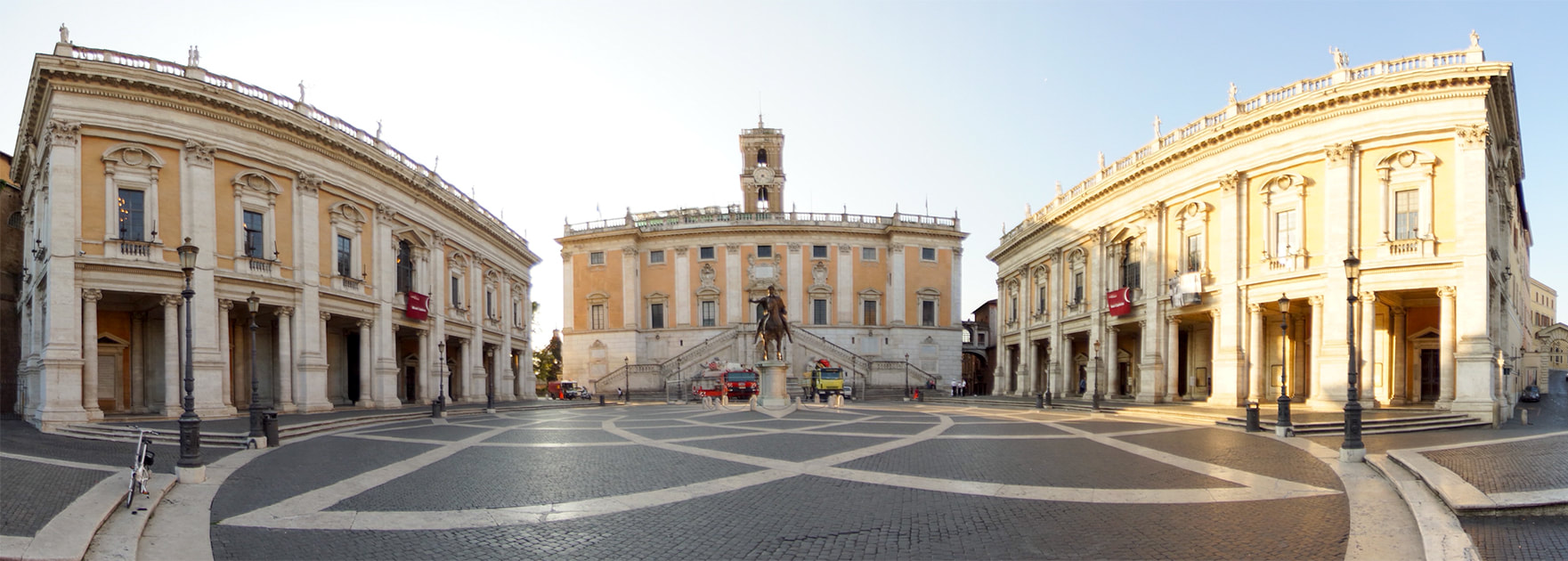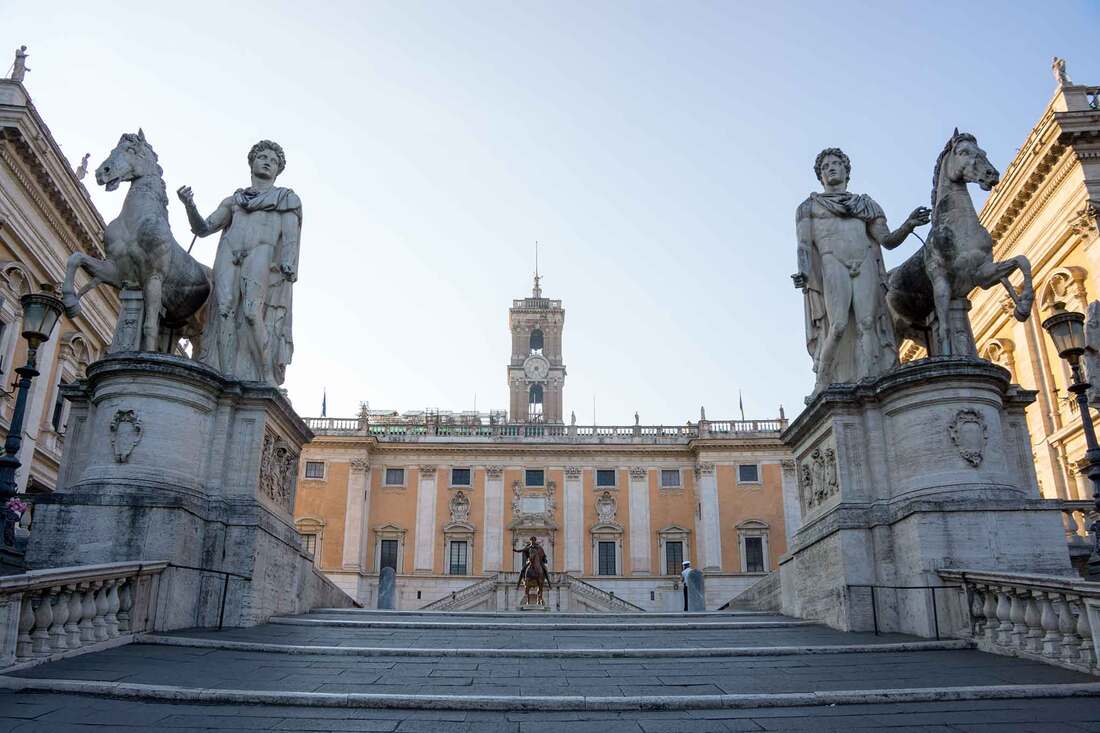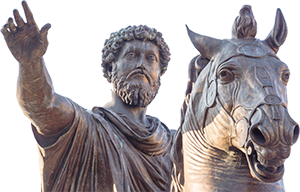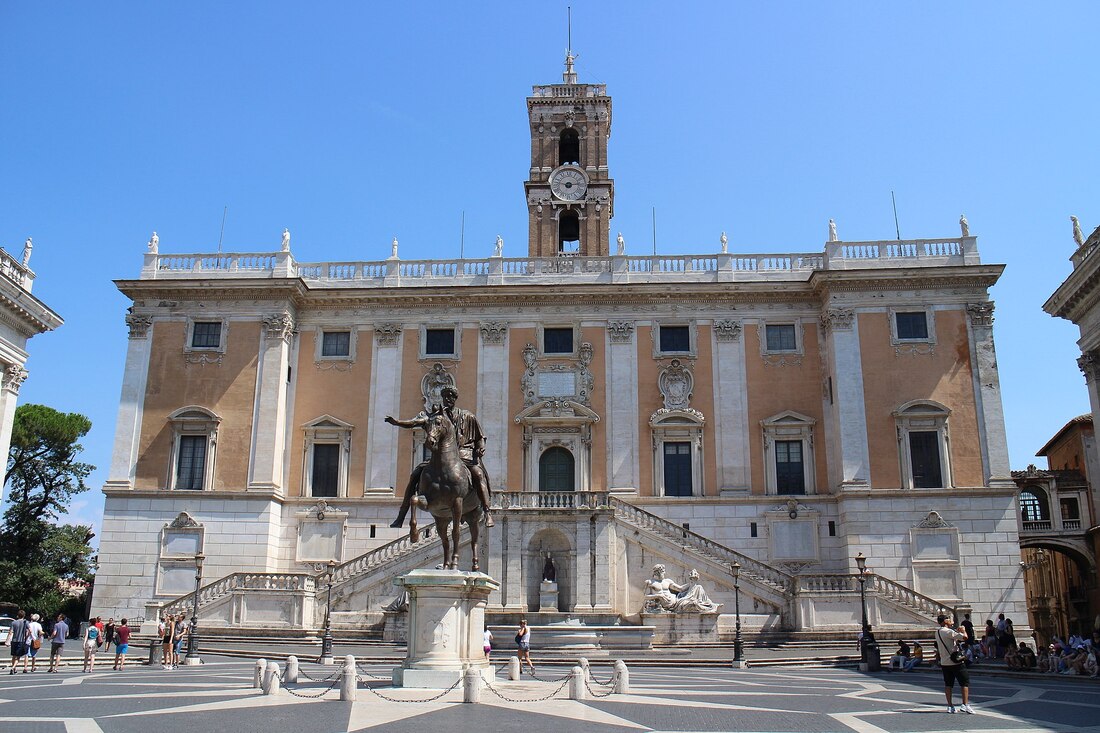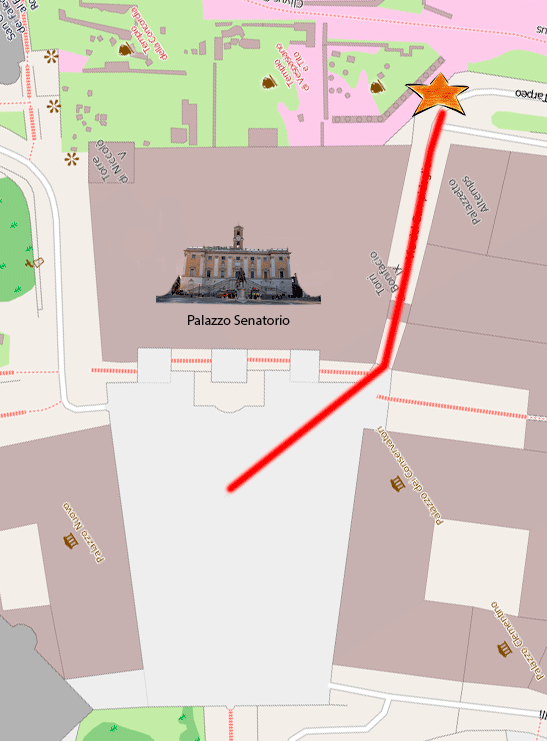Capitoline Hill is our first stop during this tour.
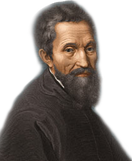 Michelangelo
Michelangelo
Quick Facts:
- Michelangelo's first design dates from 1536
- He was commissioned by the Farnese Pope, Paul III
- The project was completed according to Michelangelo's plans after his death
- Michelangelo's first design dates from 1536
- He was commissioned by the Farnese Pope, Paul III
- The project was completed according to Michelangelo's plans after his death
|
|
|
The Hill will be packed with people unless you are here before 7:00 AM, because it is the ancient centre of the Roman city and the most sacred among the seven hills of Rome.
It was considered, by Romans, to be the religious centre of the world where the three pagan gods Minerva, Giuno (Juno) and Jupiter were worshiped, each in their own temple. The excellent name of Michelangelo also entices us to visit this hill.
Originally, it was in the temples on this hill, that Romans took the omens for the continuous wars they fought for centuries for the conquest of the new world. The Temple of Jupiter was the most important of the temples as it was believed to be the earthly residence of the divinity, king and father of all Gods of the ancient Roman Empire. The temple was destroyed by war and rebuilt several times; each time, with greater splendour.
The Temple of Jupiter was perched high above the Forum and was called “The Capitol” named after the Capitoline Hill. The hill and its great temple became the symbol of Rome which thought of itself as the capitol of the world. Capitoline Hill was the site where the City of Rome, and later the Roman Empire was established.
For centuries the Capitoline Hill was the goal of the triumphal processions that marched in celebration through the Forum (our next stop) after successful wars. Victorious generals climbed the hill for the celebration of the solemn sacrifices and to lay at the feet of Jupiter’s throne the spoils of war for the obtained victories. (spoils = everything they stole from the people they defeated)
With the legalization of Christianity in 312 AD, the Capital began to lose all its pagan religious importance. The temples began to close and became deserted. In 546, The Goths (Germanic tribe) burned the capital and it was during that fire that Temple of Jupiter, the symbol of Roman power, was lost. Since that disaster all the sacred sanctuaries of the Capital became a shapeless heap of rubbish, which in the course of time, passed gradually out of sight and out of mind.
During the Medieval Period, government functions began to take place on Capitol Hill. Eventually a small piazza evolved with the commune’s headquarters on one side and the seat of justice on a second side. These buildings became the foundations for the Michelangelo composition that exists today and is known as the Campidoglio. (pronouced Campee-dough-lee-oh)
Michelangelo was commissioned by Pope Paul III to design a new look for the Hill. The Pope wanted to show-off a symbol of new Rome and impress the Holy Roman Emperor, Charles V, who was expected to come for a visit in 1538. This design request gave Michelangelo the opportunity to build a monumental civic plaza for a major city as well as to reestablish the grandeur of Rome. Michelangelo’s first designs for the piazza (pronouced Pee-at-sa) and the remodeling of the surrounding palazzi (pronouced pah-lat-see) date from 1536. His plan was extensive. He reversed the orientation of the Capitoline in a symbolic gesture, turning Rome’s civic centre to face away from the Roman Forum. The buildings now face in the direction of Papal Rome and the Christian church, in the form of St. Peter’s Basilica. This half-circle turn can also be seen as Michelangelo’s desire to address the new, developing section of the city rather than the ancient and derelict forum remains of the past.
An equestrian statue thought to represent the first Christian Emperor, Constantine, was placed in the centre of the piazza. Ironically, the statue turned out to represent Marcus Aurelius not Constantine. Michelangelo was required to provide a setting for the statue and to bring order to an irregular hilltop already encumbered by two crumbling medieval buildings set at an acute angle to each other.
The central Palazzo del Senatore with its back to the Forum was to be restored with a double outer stairway, and the campanile moved to the centre axis of the palace. The Palazzo dei Conservatori was also to be restored, and a new building, called Palazzo Nuovo, was to be built at the same angle on the north side to mirror the Conservatori, creating a trapezoidal piazza. These two buildings were built specifically to be museums and were the first ever museums to be built in the world.
A long flight of 14 stairs (Scala-Cordonata) was built to lead you up to the enclosed piazza from the street below. Work proceeded very slowly and the Cordonata was not completed by the time Emperor Charles V arrived. (So, no one really knows if he was impressed or not!) The stairs were built in this manner to allow people, donkeys and horses to safely use them. Michelangelo’s plans for the wonderful pavement that fills the square were not completed until 1940 under the order of Mussolini.
What to See in Rome, Paglia, 1938, pages 296 - 298.
It was considered, by Romans, to be the religious centre of the world where the three pagan gods Minerva, Giuno (Juno) and Jupiter were worshiped, each in their own temple. The excellent name of Michelangelo also entices us to visit this hill.
Originally, it was in the temples on this hill, that Romans took the omens for the continuous wars they fought for centuries for the conquest of the new world. The Temple of Jupiter was the most important of the temples as it was believed to be the earthly residence of the divinity, king and father of all Gods of the ancient Roman Empire. The temple was destroyed by war and rebuilt several times; each time, with greater splendour.
The Temple of Jupiter was perched high above the Forum and was called “The Capitol” named after the Capitoline Hill. The hill and its great temple became the symbol of Rome which thought of itself as the capitol of the world. Capitoline Hill was the site where the City of Rome, and later the Roman Empire was established.
For centuries the Capitoline Hill was the goal of the triumphal processions that marched in celebration through the Forum (our next stop) after successful wars. Victorious generals climbed the hill for the celebration of the solemn sacrifices and to lay at the feet of Jupiter’s throne the spoils of war for the obtained victories. (spoils = everything they stole from the people they defeated)
With the legalization of Christianity in 312 AD, the Capital began to lose all its pagan religious importance. The temples began to close and became deserted. In 546, The Goths (Germanic tribe) burned the capital and it was during that fire that Temple of Jupiter, the symbol of Roman power, was lost. Since that disaster all the sacred sanctuaries of the Capital became a shapeless heap of rubbish, which in the course of time, passed gradually out of sight and out of mind.
During the Medieval Period, government functions began to take place on Capitol Hill. Eventually a small piazza evolved with the commune’s headquarters on one side and the seat of justice on a second side. These buildings became the foundations for the Michelangelo composition that exists today and is known as the Campidoglio. (pronouced Campee-dough-lee-oh)
Michelangelo was commissioned by Pope Paul III to design a new look for the Hill. The Pope wanted to show-off a symbol of new Rome and impress the Holy Roman Emperor, Charles V, who was expected to come for a visit in 1538. This design request gave Michelangelo the opportunity to build a monumental civic plaza for a major city as well as to reestablish the grandeur of Rome. Michelangelo’s first designs for the piazza (pronouced Pee-at-sa) and the remodeling of the surrounding palazzi (pronouced pah-lat-see) date from 1536. His plan was extensive. He reversed the orientation of the Capitoline in a symbolic gesture, turning Rome’s civic centre to face away from the Roman Forum. The buildings now face in the direction of Papal Rome and the Christian church, in the form of St. Peter’s Basilica. This half-circle turn can also be seen as Michelangelo’s desire to address the new, developing section of the city rather than the ancient and derelict forum remains of the past.
An equestrian statue thought to represent the first Christian Emperor, Constantine, was placed in the centre of the piazza. Ironically, the statue turned out to represent Marcus Aurelius not Constantine. Michelangelo was required to provide a setting for the statue and to bring order to an irregular hilltop already encumbered by two crumbling medieval buildings set at an acute angle to each other.
The central Palazzo del Senatore with its back to the Forum was to be restored with a double outer stairway, and the campanile moved to the centre axis of the palace. The Palazzo dei Conservatori was also to be restored, and a new building, called Palazzo Nuovo, was to be built at the same angle on the north side to mirror the Conservatori, creating a trapezoidal piazza. These two buildings were built specifically to be museums and were the first ever museums to be built in the world.
A long flight of 14 stairs (Scala-Cordonata) was built to lead you up to the enclosed piazza from the street below. Work proceeded very slowly and the Cordonata was not completed by the time Emperor Charles V arrived. (So, no one really knows if he was impressed or not!) The stairs were built in this manner to allow people, donkeys and horses to safely use them. Michelangelo’s plans for the wonderful pavement that fills the square were not completed until 1940 under the order of Mussolini.
What to See in Rome, Paglia, 1938, pages 296 - 298.
Marcus Aurelius was born on the 26 of April in the year 121 and died on 17
March, 180 CE. He was chosen by Emperor Hadrian to be his successor and was
Roman Emperor from 161 to 180. He was the last of the Five Good Emperors, and is considered one of the most important Stoic philosophers from the School of Hellenistic Philosophy, founded in Athens in the 3rd century. See Stoic information below.
The statue of Marcus Aurelius, in the centre of the square, is a copy. The original, is located in the museum on the square. The original, is the only equestrian statue preserved from the sixtysix statues which are said to have decorated Imperial Rome.
If you have a few minutes, go into the museum to see the original, as it was
entirely gilded, which means it was covered with a thin layer of gold leaf or gold paint. Some of the gilding is still preserved on the left of the horse’s neck. This statue is important is it became the prototype for later, Renaissance statues. The original location of the statue is not known, perhaps in the ninth century it stood in the vicinity of the Arch of Septimius Severus.
As hundreds of years passed, people became confused about who it was that was actually
sitting on top of the horse, and some believed it to be Constantine. It is because of this confusion that it was erected in the square. After all, who would be better to sit in the centre of the revised square, facing the Vatican, than the man who legalized Christianity!
The pedestal on which the statue sits was designed by Michelangelo. The coat of arms
of Pope Paul III is on the front. The inscription at the base of the pedestal mentions three
Conservatori who made minor changes to the pedestal at a later date.
Stoicism:
The Stoics taught that destructive emotions resulted in errors in judgment and that a person of
moral and intellectual perfection would not suffer such emotions. Stoics were concerned with the active relationship between cosmic determinism and human freedom, and the belief that it is virtuous to maintain a will (called prohairesis) that is in accord with nature. Because of this, the Stoics presented their philosophy as a way of life, and they thought that the best indication of an individual’s philosophy was not what a person said but how that person behaved.
Wikipedia
Equestrian Statues and Horses Hooves:
The position of the legs of horses are said to have significance of meaning, although no one really seems to follow any rules about it. It is fun to think about though.
March, 180 CE. He was chosen by Emperor Hadrian to be his successor and was
Roman Emperor from 161 to 180. He was the last of the Five Good Emperors, and is considered one of the most important Stoic philosophers from the School of Hellenistic Philosophy, founded in Athens in the 3rd century. See Stoic information below.
The statue of Marcus Aurelius, in the centre of the square, is a copy. The original, is located in the museum on the square. The original, is the only equestrian statue preserved from the sixtysix statues which are said to have decorated Imperial Rome.
If you have a few minutes, go into the museum to see the original, as it was
entirely gilded, which means it was covered with a thin layer of gold leaf or gold paint. Some of the gilding is still preserved on the left of the horse’s neck. This statue is important is it became the prototype for later, Renaissance statues. The original location of the statue is not known, perhaps in the ninth century it stood in the vicinity of the Arch of Septimius Severus.
As hundreds of years passed, people became confused about who it was that was actually
sitting on top of the horse, and some believed it to be Constantine. It is because of this confusion that it was erected in the square. After all, who would be better to sit in the centre of the revised square, facing the Vatican, than the man who legalized Christianity!
The pedestal on which the statue sits was designed by Michelangelo. The coat of arms
of Pope Paul III is on the front. The inscription at the base of the pedestal mentions three
Conservatori who made minor changes to the pedestal at a later date.
Stoicism:
The Stoics taught that destructive emotions resulted in errors in judgment and that a person of
moral and intellectual perfection would not suffer such emotions. Stoics were concerned with the active relationship between cosmic determinism and human freedom, and the belief that it is virtuous to maintain a will (called prohairesis) that is in accord with nature. Because of this, the Stoics presented their philosophy as a way of life, and they thought that the best indication of an individual’s philosophy was not what a person said but how that person behaved.
Wikipedia
Equestrian Statues and Horses Hooves:
The position of the legs of horses are said to have significance of meaning, although no one really seems to follow any rules about it. It is fun to think about though.
- If one hoof is raised, it is said that the rider was wounded in battle.
- Two hooves raised mean the rider was killed in battle.
- All four on the ground mean that the rider was not a casualty of war.
Palazzo Senatoria
The original Senatorio building was built in the 12th century on the remains of the ancient Tabularium. The Tabularium was a building from the first century which housed Roman records of state; the laws and official acts, which were engraved on tabulae, made of bronze.
Today’s Senatorio building is named as it is, because it was originally used as the senatorial seat for the administration of justice.
Michelangelo used the original building as his foundation but made Classical changes to it by adding a monumental double-flighted staircase as well as dividing the façade by the use of pilasters and large windows. The windows are topped with Pediments, where he alternates curved pediments with pointed pediments.
Michelangelo employs, here, for the first time in history, “two storey pilasters” which are called Giant Order of Pilasters. Typically, pilasters were only one storey high, but these pilasters cover two storeys. They are Roman pilasters with Corinthian capitals.
He also added the “Balustrade” which is the rail-like structure at the top of the building featuring a number of statues.
This building was competed after Michelangelo’s death by the well-known, Giacomo della Porta. (Generally referred to as della Porta)
The building originally had a medieval bell tower located toward the left side. It was struck by lightning in 1577 and was rebuilt at the centre of the palace by Martino Longhi the Elder during the reign of Pope Gregory XIII.
Terms:
Façade: (pronounced: fa-sod)
Principle front of a building.
Pediment: (pronounced: pedd-e-ment)
The triangular end surface or low gable end of a building constructed in the Classical or Renaissance style, often with elaborate sculpture or statues in front, and usually framed with a cornice. Pediments were also used to decoratively crown important windows. A broken pediment is a pediment that is broken in the centre.
A Dictionary of Art Terms, Reginald Haggar.
Today’s Senatorio building is named as it is, because it was originally used as the senatorial seat for the administration of justice.
Michelangelo used the original building as his foundation but made Classical changes to it by adding a monumental double-flighted staircase as well as dividing the façade by the use of pilasters and large windows. The windows are topped with Pediments, where he alternates curved pediments with pointed pediments.
Michelangelo employs, here, for the first time in history, “two storey pilasters” which are called Giant Order of Pilasters. Typically, pilasters were only one storey high, but these pilasters cover two storeys. They are Roman pilasters with Corinthian capitals.
He also added the “Balustrade” which is the rail-like structure at the top of the building featuring a number of statues.
This building was competed after Michelangelo’s death by the well-known, Giacomo della Porta. (Generally referred to as della Porta)
The building originally had a medieval bell tower located toward the left side. It was struck by lightning in 1577 and was rebuilt at the centre of the palace by Martino Longhi the Elder during the reign of Pope Gregory XIII.
Terms:
Façade: (pronounced: fa-sod)
Principle front of a building.
Pediment: (pronounced: pedd-e-ment)
The triangular end surface or low gable end of a building constructed in the Classical or Renaissance style, often with elaborate sculpture or statues in front, and usually framed with a cornice. Pediments were also used to decoratively crown important windows. A broken pediment is a pediment that is broken in the centre.
A Dictionary of Art Terms, Reginald Haggar.
Palazzo dei Conservatori and Palazzo Nuovo
The original Palazzo dei Conservatori, or Palace of the Conservators, was built in the Middle Ages on top of the sixth-century BCE temple that was dedicated to Jupiter Maximus Capitolinus. Jupiter was the king of the gods and the god of sky and thunder. Ruins of the Temple of Jupiter are visible through openings in the walls. The Conservatori was used as the seat of an elected magistrate, who had the task of administering the city.
Michelangelo redesigned the façade and incorporated the first use of giant pilasters which spanned two storeys.
The portico (covered walkway) contains entablatures, and a flat, coffer-like ceiling. The entablatures rest on columns set at the front of each portico bay, while matching half-columns stand against the back wall. Each pilaster forms a compound unit with the pier and column on either side of it. Colossal pilasters set on large bases join the portico and the upper story. All windows are capped with segmental pediments.
The façade was updated by Michelangelo in the 1530s and numerous times after that. The portico of the Palazzo dei Conservatori housed offices of various guilds where disputes arising in the transaction of business were adjudicated, unless they were of sufficient importance to go before a communal tribunal, such as that of the Conservatori.
Until the 1470s, the main market of the city was held on and around the Campidoglio, while cattle continued to be taxed and sold in the ancient Forum located just behind it and down the hill, to the south.
To complete the piazza’s symmetry and cover up the tower of the Aracoeli, the Palazzo Nuovo, or New Palace, was begun in 1603, finished in 1654. It was opened to the public in 1734. Its façade duplicates that of Palazzo dei Conservatori. In other words, it is an identical copy made using Michelangelo’s design.
Wikipedia
Terms:
Aracoeli; Basilica di Santa Maria in Ara coeli: The church located on the top of the hill to the left of the Cordonata.
Baluster: A short pillar used to support a handrail or molded coping.
Balustrade: A continuous row of balusters surmounted by a handrail or coping.
Entablature: The horizontal upper part of any classical order building or temple. It is supported by a range of columns, piers or walls and consists of three horizontal sections; the lowest is the Architrave, the middle is the Frieze and the Cornice is the topmost part.
Façade: The front of a building
Gilding: The covering of surfaces with a thin layer of gold.
Guild: An association of artisans or merchants whocontrol the practice of their craft in a particular town, much like to the trade unions we have today.
Palazzo: Palace, building or mansion. (pronounced: pa-latt-so)
Piazza: A public square, market place, or open space. (pronounced: pee-at-ssa)
Pilaster: A shallow rectangular part of a column that projects between one quarter or one-half from the wall to which it is attached. It is different from a column or pier as these have a greater projection from a wall.
Portico: A covered walkway in front of a building, enclosed by regularly placed columns. (pronounced: port-eh-co)
A Dictionary of Art Terms by Reginald Haggar.
Michelangelo redesigned the façade and incorporated the first use of giant pilasters which spanned two storeys.
The portico (covered walkway) contains entablatures, and a flat, coffer-like ceiling. The entablatures rest on columns set at the front of each portico bay, while matching half-columns stand against the back wall. Each pilaster forms a compound unit with the pier and column on either side of it. Colossal pilasters set on large bases join the portico and the upper story. All windows are capped with segmental pediments.
The façade was updated by Michelangelo in the 1530s and numerous times after that. The portico of the Palazzo dei Conservatori housed offices of various guilds where disputes arising in the transaction of business were adjudicated, unless they were of sufficient importance to go before a communal tribunal, such as that of the Conservatori.
Until the 1470s, the main market of the city was held on and around the Campidoglio, while cattle continued to be taxed and sold in the ancient Forum located just behind it and down the hill, to the south.
To complete the piazza’s symmetry and cover up the tower of the Aracoeli, the Palazzo Nuovo, or New Palace, was begun in 1603, finished in 1654. It was opened to the public in 1734. Its façade duplicates that of Palazzo dei Conservatori. In other words, it is an identical copy made using Michelangelo’s design.
Wikipedia
Terms:
Aracoeli; Basilica di Santa Maria in Ara coeli: The church located on the top of the hill to the left of the Cordonata.
Baluster: A short pillar used to support a handrail or molded coping.
Balustrade: A continuous row of balusters surmounted by a handrail or coping.
Entablature: The horizontal upper part of any classical order building or temple. It is supported by a range of columns, piers or walls and consists of three horizontal sections; the lowest is the Architrave, the middle is the Frieze and the Cornice is the topmost part.
Façade: The front of a building
Gilding: The covering of surfaces with a thin layer of gold.
Guild: An association of artisans or merchants whocontrol the practice of their craft in a particular town, much like to the trade unions we have today.
Palazzo: Palace, building or mansion. (pronounced: pa-latt-so)
Piazza: A public square, market place, or open space. (pronounced: pee-at-ssa)
Pilaster: A shallow rectangular part of a column that projects between one quarter or one-half from the wall to which it is attached. It is different from a column or pier as these have a greater projection from a wall.
Portico: A covered walkway in front of a building, enclosed by regularly placed columns. (pronounced: port-eh-co)
A Dictionary of Art Terms by Reginald Haggar.
Directions: Campidoglio to the Forum - Distance: 250M Time to walk: 2 Min
- Face Palazzo Senatorio.
- Walk toward the right side of the building
- Pass through the alleyway
- Stop at the back of the building, look to your left, and you will see the best view in Rome of the Forum.
